[[{"fid":"1255","view_mode":"content_full_hd","fields":{"format":"content_full_hd","field_file_image_alt_text[und][0][value]":"Solar CITIES 3 IBC Conference Poster","field_file_image_title_text[und][0][value]":"Solar CITIES 3 IBC Conference Poster","field_folder[und]":"123"},"type":"media","field_deltas":{"1":{"format":"content_full_hd","field_file_image_alt_text[und][0][value]":"Solar CITIES 3 IBC Conference Poster","field_file_image_title_text[und][0][value]":"Solar CITIES 3 IBC Conference Poster","field_folder[und]":"123"}},"attributes":{"alt":"Solar CITIES 3 IBC Conference Poster","title":"Solar CITIES 3 IBC Conference Poster","height":"1584","width":"1120","style":"font-size: 1.385em; line-height: 1.538em;","class":"media-element file-content-full-hd","data-delta":"1"}}]]
*pdf available here: [[{"fid":"1256","view_mode":"wysiwyg","fields":{"format":"wysiwyg","field_folder[und]":"123"},"type":"media","link_text":"solarcities_poster.pdf","field_deltas":{"2":{"format":"wysiwyg","field_folder[und]":"123"}},"attributes":{"class":"file media-element file-wysiwyg","data-delta":"2"}}]]
Creating your own Solar CITIES 3 IBC digester:
Making your own Solar CITIES IBC Tote Tank Biodigester has never been easier!!
Here's all you need to do to jump into the backyard or basement biogas game and become a first flamer (yes, you can build them on your roof, porch or patio too!):
[[{"fid":"1849","view_mode":"content_full_hd","fields":{"format":"content_full_hd","field_file_image_alt_text[und][0][value]":"The finished Solar CITIES Floating IBC biogas system","field_file_image_title_text[und][0][value]":"The finished Solar CITIES Floating IBC biogas system"},"type":"media","field_deltas":{"129":{"format":"content_medium","field_file_image_alt_text[und][0][value]":"Whole System Complete","field_file_image_title_text[und][0][value]":"Whole System Complete"},"133":{"format":"content_full_hd","field_file_image_alt_text[und][0][value]":"The finished Solar CITIES Floating IBC biogas system","field_file_image_title_text[und][0][value]":"The finished Solar CITIES Floating IBC biogas system"}},"attributes":{"alt":"The finished Solar CITIES Floating IBC biogas system","title":"The finished Solar CITIES Floating IBC biogas system","class":"media-element file-content-full-hd","data-delta":"133"}}]]
The 3d diagram below is more or less correct except we now use 4 inch pipe and uniseal for the feeding pipe insead of 3 inch and we use a Big Gulp Dust Hoold with 4 inch outlet as a funnel:
[[{"fid":"1314","view_mode":"content_full_hd","fields":{"format":"content_full_hd","field_file_image_alt_text[und][0][value]":"Making an IBC biodigester is as easy as ABC","field_file_image_title_text[und][0][value]":"Making an IBC biodigester is as easy as ABC","field_folder[und]":"123"},"type":"media","field_deltas":{"3":{"format":"content_full_hd","field_file_image_alt_text[und][0][value]":"Making an IBC biodigester is as easy as ABC","field_file_image_title_text[und][0][value]":"Making an IBC biodigester is as easy as ABC","field_folder[und]":"123"}},"attributes":{"alt":"Making an IBC biodigester is as easy as ABC","title":"Making an IBC biodigester is as easy as ABC","height":"630","width":"1120","class":"media-element file-content-full-hd","data-delta":"3"}}]]
TOOLS YOU WILL NEED:
Allen Key set of various sizes and/or Torx head screwdriver (T40 for most IBCs) to remove bars from top of IBC cag ("To remove the two locking bars" says http://carazy.net/how-to-build-a-wicking-garden-bed-using-an-ibc-tote/ , use " a T40 Torx head screwdriver. In a pinch, if your screws aren’t tight you might be able to get away with using an Allen Key that fits". ) Of course you will need some way to grip these -- a cordless drill or a screw driver handle made for interchangeable heads.
[[{"fid":"1315","view_mode":"content_medium","fields":{"format":"content_medium","field_file_image_alt_text[und][0][value]":"Torx Star Screwdriver Heads","field_file_image_title_text[und][0][value]":"Torx Star Screwdriver Heads","field_folder[und]":"123"},"type":"media","field_deltas":{"4":{"format":"content_medium","field_file_image_alt_text[und][0][value]":"Torx Star Screwdriver Heads","field_file_image_title_text[und][0][value]":"Torx Star Screwdriver Heads","field_folder[und]":"123"}},"attributes":{"alt":"Torx Star Screwdriver Heads","title":"Torx Star Screwdriver Heads","height":"230","width":"400","style":"width: 100px; height: 58px;","class":"media-element file-content-medium","data-delta":"4"}}]]
[[{"fid":"1316","view_mode":"content_medium","fields":{"format":"content_medium","field_file_image_alt_text[und][0][value]":"Removing the top bars of the IBC","field_file_image_title_text[und][0][value]":"Removing the top bars of the IBC","field_folder[und]":"123"},"type":"media","field_deltas":{"5":{"format":"content_medium","field_file_image_alt_text[und][0][value]":"Removing the top bars of the IBC","field_file_image_title_text[und][0][value]":"Removing the top bars of the IBC","field_folder[und]":"123"}},"attributes":{"alt":"Removing the top bars of the IBC","title":"Removing the top bars of the IBC","height":"225","width":"400","style":"width: 100px; height: 56px;","class":"media-element file-content-medium","data-delta":"5"}}]]
Hacksaw or electric saw to cut pipes and cut top off of IBC used for bottom of floating gas holder
[[{"fid":"1317","view_mode":"content_medium","fields":{"format":"content_medium","field_file_image_alt_text[und][0][value]":"Hacksaw","field_file_image_title_text[und][0][value]":"Hacksaw","field_folder[und]":"123"},"type":"media","field_deltas":{"6":{"format":"content_medium","field_file_image_alt_text[und][0][value]":"Hacksaw","field_file_image_title_text[und][0][value]":"Hacksaw","field_folder[und]":"123"}},"attributes":{"alt":"Hacksaw","title":"Hacksaw","height":"400","width":"400","style":"width: 100px; height: 100px;","class":"media-element file-content-medium","data-delta":"6"}}]]
PVC Cutter (nice to have but not strictly necessary. Saves a lot of time). If you can get one that cuts 2 inch pipes, great. You will be using a hacksaw for the 3 or 4 inch pipes and could use it for the 2 inch pipes too. The PVC cutter is especially handy for the little 1/2 inch pipe sections.
[[{"fid":"1318","view_mode":"content_medium","fields":{"format":"content_medium","field_file_image_alt_text[und][0][value]":"PVC cutter","field_file_image_title_text[und][0][value]":"PVC cutter","field_folder[und]":"123"},"type":"media","field_deltas":{"7":{"format":"content_medium","field_file_image_alt_text[und][0][value]":"PVC cutter","field_file_image_title_text[und][0][value]":"PVC cutter","field_folder[und]":"123"}},"attributes":{"alt":"PVC cutter","title":"PVC cutter","height":"247","width":"400","style":"width: 100px; height: 62px;","class":"media-element file-content-medium","data-delta":"7"}}]]
Hole saws. To make the holes in the tanks to fit the uniseals snugly you should have a range of hole saws. You don't want to try to cut these holes with a knife as it is very hard to make them perfectly round and then the uniseals won't work!! They will leak!.
You will need a 3 inch hole saw for a 2 inch uniseal, a 4 inch hole saw for a 3 inch uniseal and a 5 inch hole saw for a 4 inch uniseal. 5 inch hole saws are really hard to find and can be expensive .
[[{"fid":"1319","view_mode":"content_medium","fields":{"format":"content_medium","field_file_image_alt_text[und][0][value]":"Hole saws","field_file_image_title_text[und][0][value]":"Hole saws","field_folder[und]":"123"},"type":"media","field_deltas":{"8":{"format":"content_medium","field_file_image_alt_text[und][0][value]":"Hole saws","field_file_image_title_text[und][0][value]":"Hole saws","field_folder[und]":"123"}},"attributes":{"alt":"Hole saws","title":"Hole saws","height":"230","width":"400","style":"width: 100px; height: 58px;","class":"media-element file-content-medium","data-delta":"8"}}]]
If you are going to use hole saws it is necessary to have a drill. We recommend a cordless rechargeable drill because you are often in places where there is no electricity.
[[{"fid":"1325","view_mode":"content_medium","fields":{"format":"content_medium","field_file_image_alt_text[und][0][value]":"Cordless Drill","field_file_image_title_text[und][0][value]":"Cordless Drill","field_folder[und]":"123"},"type":"media","field_deltas":{"9":{"format":"content_medium","field_file_image_alt_text[und][0][value]":"Cordless Drill","field_file_image_title_text[und][0][value]":"Cordless Drill","field_folder[und]":"123"}},"attributes":{"alt":"Cordless Drill","title":"Cordless Drill","height":"400","width":"400","style":"width: 100px; height: 100px;","class":"media-element file-content-medium","data-delta":"9"}}]]
If you don't have a drill or you have one with a dead battery of an electric one with no electric socket to plug into, you can heat up the hole saw with a torch or on a fire and melt the hole into the IBC.
And you can do this same thing with no hole saws at all, by getting....
...Metal pipes of various sizes. If hole saws aren't available in the right sizes, we can always melt holes through the IBC tank using heated metal pipes. In Ireland, working with Eimhin David Callanan, we found that a stove pipe in the hardward store was 5 inches, good for making holes for a 4 inch uniseal for a 4 inch pipe. A paint can mixer was 4 inches and we were able to heat it up to fit the 3 inch uniseal for a 3 inch pipe.
[[{"fid":"1320","view_mode":"content_medium","fields":{"format":"content_medium","field_file_image_alt_text[und][0][value]":"4 inch metal pipe for 3 inch uniseal","field_file_image_title_text[und][0][value]":"4 inch metal pipe for 3 inch uniseal","field_folder[und]":"123"},"type":"media","field_deltas":{"10":{"format":"content_medium","field_file_image_alt_text[und][0][value]":"4 inch metal pipe for 3 inch uniseal","field_file_image_title_text[und][0][value]":"4 inch metal pipe for 3 inch uniseal","field_folder[und]":"123"}},"attributes":{"alt":"4 inch metal pipe for 3 inch uniseal","title":"4 inch metal pipe for 3 inch uniseal","height":"221","width":"400","style":"width: 100px; height: 55px;","class":"media-element file-content-medium","data-delta":"10"}}]]
The 4 inch pipe above could be used for the hole for the 3 inch pipe's uniseal.
[[{"fid":"1321","view_mode":"content_medium","fields":{"format":"content_medium","field_file_image_alt_text[und][0][value]":"5 inch stove pipe","field_file_image_title_text[und][0][value]":"5 inch stove pipe","field_folder[und]":"123"},"type":"media","field_deltas":{"11":{"format":"content_medium","field_file_image_alt_text[und][0][value]":"5 inch stove pipe","field_file_image_title_text[und][0][value]":"5 inch stove pipe","field_folder[und]":"123"}},"attributes":{"alt":"5 inch stove pipe","title":"5 inch stove pipe","height":"442","width":"400","style":"width: 100px; height: 111px;","class":"media-element file-content-medium","data-delta":"11"}}]]
The 5 inch pipe above could be used for the hole for the 4 inch pipe's uniseal.
Very occasionally you can find a paint mixer with the right diameter for melting the hole. In Ireland we found one that was 83 mm that just fit the 3 inch uniseal we had. We were lucky. You have to bring your uniseals with you and test them against the diameter of the metal pipe or paint mixer before you buy. You want them to be within a mm.
[[{"fid":"1322","view_mode":"content_full_hd","fields":{"format":"content_full_hd","field_file_image_alt_text[und][0][value]":"Paint mixer 83 mm","field_file_image_title_text[und][0][value]":"Paint mixer 83 mm","field_folder[und]":"123"},"type":"media","field_deltas":{"12":{"format":"content_full_hd","field_file_image_alt_text[und][0][value]":"Paint mixer 83 mm","field_file_image_title_text[und][0][value]":"Paint mixer 83 mm","field_folder[und]":"123"}},"attributes":{"alt":"Paint mixer 83 mm","title":"Paint mixer 83 mm","height":"208","width":"678","style":"width: 100px; height: 31px;","class":"media-element file-content-full-hd","data-delta":"12"}}]]
If you can get an assortment of metal pipes you will want one that is 3" for the two inch uniseal hole, and then see if you can find 4 or 5 inch for the 3 and 4 inch uniseals respectively.
[[{"fid":"1323","view_mode":"content_medium","fields":{"format":"content_medium","field_file_image_alt_text[und][0][value]":"Metal pipes","field_file_image_title_text[und][0][value]":"Metal pipes","field_folder[und]":"123"},"type":"media","field_deltas":{"13":{"format":"content_medium","field_file_image_alt_text[und][0][value]":"Metal pipes","field_file_image_title_text[und][0][value]":"Metal pipes","field_folder[und]":"123"}},"attributes":{"alt":"Metal pipes","title":"Metal pipes","height":"384","width":"400","style":"width: 100px; height: 96px;","class":"media-element file-content-medium","data-delta":"13"}}]]
If you are going to go the route of using metal pipes to melt your holes you will need a way to heat them up. We've made fires from wood, charcoal and from garbage, but the best and least polluting way to do it is to use natural gas. When we have had biogas available we have used that! Otherwise, heat them up red hot with a propane torch.
[[{"fid":"1324","view_mode":"content_medium","fields":{"format":"content_medium","field_file_image_alt_text[und][0][value]":"Propane Torch","field_file_image_title_text[und][0][value]":"Propane Torch","field_folder[und]":"123"},"type":"media","field_deltas":{"14":{"format":"content_medium","field_file_image_alt_text[und][0][value]":"Propane Torch","field_file_image_title_text[und][0][value]":"Propane Torch","field_folder[und]":"123"}},"attributes":{"alt":"Propane Torch","title":"Propane Torch","height":"400","width":"400","style":"width: 100px; height: 100px;","class":"media-element file-content-medium","data-delta":"14"}}]]
You should also have a pair of scissors for cutting duct tape and plastic and string.
[[{"fid":"1326","view_mode":"content_medium","fields":{"format":"content_medium","field_file_image_alt_text[und][0][value]":"Scissors","field_file_image_title_text[und][0][value]":"Scissors","field_folder[und]":"123"},"type":"media","field_deltas":{"15":{"format":"content_medium","field_file_image_alt_text[und][0][value]":"Scissors","field_file_image_title_text[und][0][value]":"Scissors","field_folder[und]":"123"}},"attributes":{"alt":"Scissors","title":"Scissors","height":"165","width":"400","style":"width: 100px; height: 41px;","class":"media-element file-content-medium","data-delta":"15"}}]]
And a couple of screwdrivers, both star (phillips) and regular.
[[{"fid":"1327","view_mode":"content_medium","fields":{"format":"content_medium","field_file_image_alt_text[und][0][value]":"Screwdrivers","field_file_image_title_text[und][0][value]":"Screwdrivers","field_folder[und]":"123"},"type":"media","field_deltas":{"16":{"format":"content_medium","field_file_image_alt_text[und][0][value]":"Screwdrivers","field_file_image_title_text[und][0][value]":"Screwdrivers","field_folder[und]":"123"}},"attributes":{"alt":"Screwdrivers","title":"Screwdrivers","height":"412","width":"400","style":"width: 100px; height: 103px;","class":"media-element file-content-medium","data-delta":"16"}}]]
If you got white IBCs you need a paintbrush (though in Florida we didn't have one and used plastic bags to smear the paint on). If you have black IBCs you don't need to paint anything.
[[{"fid":"1328","view_mode":"content_medium","fields":{"format":"content_medium","field_file_image_alt_text[und][0][value]":"Paint brush","field_file_image_title_text[und][0][value]":"Paint brush","field_folder[und]":"123"},"type":"media","field_deltas":{"17":{"format":"content_medium","field_file_image_alt_text[und][0][value]":"Paint brush","field_file_image_title_text[und][0][value]":"Paint brush","field_folder[und]":"123"}},"attributes":{"alt":"Paint brush","title":"Paint brush","height":"378","width":"400","style":"width: 100px; height: 95px;","class":"media-element file-content-medium","data-delta":"17"}}]]
That covers the basic tools you will need for this job.
Part I: Creating the Stomach of your Fire Breathing Dragon:
The following TedX Talk by Solar CITIES vice president and treasurer and board members Janice Kelsey and Jody Spangler, shows the basic construction of the latest design of the Solar CITIES IBC digester or "domestic dragon" in very simple terms.
[[{"fid":"1339","view_mode":"default","fields":{"format":"default","field_folder[und]":"123"},"type":"media","link_text":"Home-Scale Biodigester | Janice Kelsey & Jody Spangler | TEDxVillanovaU","field_deltas":{"18":{"format":"default","field_folder[und]":"123"}},"attributes":{"class":"file media-element file-default","data-delta":"18"}}]]
Here is the procedure for building it:
1) Get three IBC tanks.
One is for the primary digester. The other two are for the floating gas holder set up.
Try to get a black IBC for the primary digester if you can, otherwise you will be painting it black. The gas holder tanks can be any color, unless you want them to serve as a secondary digester, in which case try to get them black too!
Before you buy the tank inspect it for damage. Make sure the neck of the opening on top is not damaged and that the screw cap has an intact rubber o-ring so it can seal airtight.
We used to try to get ones with a screw lid that has a 2 inch screw thread port in the lid so we could make the gas holder come out of the lid. We don't do that much any more, preferring instead to put a 2 inch bulkhead fitting NEXT TO the lid, and leaving the lid as an access port for being able to easily put surface area improvements (bags of recycled water bottle caps for example) into the tank and to service the tank if we want to remove sludge. If it doesn't have the threaded two inch hole we also used to use a uniseal as in our video tutorial. Things were easier and faster if the lid had a screw plug with the appropriate two inch plumbing threads. But every tank has a different size lid with different characteristics, so to standardize things we now use the bulkhead fitting and put it next to the lid (see pictures below).
[[{"fid":"1227","view_mode":"content_medium","fields":{"format":"content_medium","field_file_image_alt_text[und][0][value]":"IBC tank","field_file_image_title_text[und][0][value]":"IBC tank","field_folder[und]":"123"},"type":"media","field_deltas":{"19":{"format":"content_medium","field_file_image_alt_text[und][0][value]":"IBC tank","field_file_image_title_text[und][0][value]":"IBC tank","field_folder[und]":"123"}},"attributes":{"alt":"IBC tank","title":"IBC tank","height":"416","width":"400","style":"width: 100px; height: 104px;","class":"media-element file-content-medium","data-delta":"19"}}]]
________________________________________________________________________________________________________________________________________________________________________________________________________________________________
NOTE: WE ARE NO LONGER USING THE DRAIN VALVES FOR ANYTHING BECAUSE IT IS OFTEN TOO DIFFICULT TO GET FITTINGS. YOU CAN IGNORE THIS FOLLOWING SECTION IF YOU LIKE:
IT IS BEST IF YOU CAN GET TANKS THAT HAVE DRAIN VALVE THAT HAVE 2 INCH MALE THREADS. YOU DON'T WANT THE BOLT ON VALVES!!! (If you get one you will have to buy a special adaptor to be able to use common plumbing parts with it!).
[[{"fid":"1329","view_mode":"content_medium","fields":{"format":"content_medium","field_file_image_alt_text[und][0][value]":"IBC ball valves","field_file_image_title_text[und][0][value]":"IBC ball valves","field_folder[und]":"123"},"type":"media","field_deltas":{"20":{"format":"content_medium","field_file_image_alt_text[und][0][value]":"IBC ball valves","field_file_image_title_text[und][0][value]":"IBC ball valves","field_folder[und]":"123"}},"attributes":{"alt":"IBC ball valves","title":"IBC ball valves","height":"421","width":"400","style":"width: 100px; height: 105px;","class":"media-element file-content-medium","data-delta":"20"}}]]
In the picture above you want the left middle or the top right and bottom right. You don't want the others because you can't easily screw a 2 inch female threaded adapter on them. You want something like this one depicted below. All IBCs should come with a valve, just check to see that it is something you can easily screw threaded pipe adapter to. To see, you may have to remove whatever cap is already on it (shown in red in the picture of the IBC up above).
[[{"fid":"1330","view_mode":"content_medium","fields":{"format":"content_medium","field_file_image_alt_text[und][0][value]":"IBC valve with male threads, 2 inch","field_file_image_title_text[und][0][value]":"IBC valve with male threads, 2 inch","field_folder[und]":"123"},"type":"media","field_deltas":{"21":{"format":"content_medium","field_file_image_alt_text[und][0][value]":"IBC valve with male threads, 2 inch","field_file_image_title_text[und][0][value]":"IBC valve with male threads, 2 inch","field_folder[und]":"123"}},"attributes":{"alt":"IBC valve with male threads, 2 inch","title":"IBC valve with male threads, 2 inch","height":"279","width":"400","style":"width: 100px; height: 70px;","class":"media-element file-content-medium","data-delta":"21"}}]]
___________________________________________________________________________________________________________________________________________________________________________________________________________________________________
2) Order 5 uniseals and two bulkhead fittings.
We recommend a 4 inch uniseal for the feeding pipe and three two inch uniseals (one for the fertilizer out pipe, and two backups in case you need to go through a lid that has no threaded hole, and one spare) and one 1/2 inch uniseal (useful for the slurry bucket valve). We also recommend two 2 inch bulkhead fittings, one for the gas out of the digester and one for the gas in/out tube of the gas holder tank.
We put plumber's silicone grease in between the uniseal and the tank to form a more reliable seal:
[[{"fid":"1334","view_mode":"content_medium","fields":{"format":"content_medium","field_file_image_alt_text[und][0][value]":"Silicone","field_file_image_title_text[und][0][value]":"Silicone","field_folder[und]":"123"},"type":"media","field_deltas":{"22":{"format":"content_medium","field_file_image_alt_text[und][0][value]":"Silicone","field_file_image_title_text[und][0][value]":"Silicone","field_folder[und]":"123"}},"attributes":{"alt":"Silicone","title":"Silicone","height":"229","width":"400","style":"width: 100px; height: 57px;","class":"media-element file-content-medium","data-delta":"22"}}]]
We get ours mostly from http://www.aussieglobe.com/ . If you are building in your basement connected to your food waste grinder or in the backyard or patio connected to a pump connected to a food grinder like the Insinkerator, you can use two inch uniseals and pipes for everything as shown in the video and only need three 2 inch uniseals and one half inch. If you are feeding manually you will be better off using a 4 inch pipe for the feeding pipe, hench you will need a 4 inch uniseal.
Thus we suggest you order one 4" uniseal and three 2" uniseals and one 1/2 uniseal and two 2" bulkhead fittings -- slip to slip. This way you are rather safe. You may end up with one or two extra 2 inch uniseals but you will have your bases covered.
[[{"fid":"1228","view_mode":"default","fields":{"format":"default","field_file_image_alt_text[und][0][value]":"Uniseal top view","field_file_image_title_text[und][0][value]":"Uniseal top view","field_folder[und]":"123"},"type":"media","field_deltas":{"23":{"format":"default","field_file_image_alt_text[und][0][value]":"Uniseal top view","field_file_image_title_text[und][0][value]":"Uniseal top view","field_folder[und]":"123"}},"attributes":{"alt":"Uniseal top view","title":"Uniseal top view","height":"100","width":"100","style":"width: 100px; height: 100px;","class":"media-element file-default","data-delta":"23"}}]]
[[{"fid":"1229","view_mode":"content_medium","fields":{"format":"content_medium","field_file_image_alt_text[und][0][value]":"Uniseal side view","field_file_image_title_text[und][0][value]":"Uniseal side view","field_folder[und]":"123"},"type":"media","field_deltas":{"24":{"format":"content_medium","field_file_image_alt_text[und][0][value]":"Uniseal side view","field_file_image_title_text[und][0][value]":"Uniseal side view","field_folder[und]":"123"}},"attributes":{"alt":"Uniseal side view","title":"Uniseal side view","height":"183","width":"400","style":"font-size: 13.008px; line-height: 1.538em; width: 187px; height: 85px;","class":"media-element file-content-medium","data-delta":"24"}}]]
[[{"fid":"1230","view_mode":"default","fields":{"format":"default","field_file_image_alt_text[und][0][value]":"Uniseal bottom view","field_file_image_title_text[und][0][value]":"Uniseal bottom view","field_folder[und]":"123"},"type":"media","field_deltas":{"25":{"format":"default","field_file_image_alt_text[und][0][value]":"Uniseal bottom view","field_file_image_title_text[und][0][value]":"Uniseal bottom view","field_folder[und]":"123"}},"attributes":{"alt":"Uniseal bottom view","title":"Uniseal bottom view","height":"100","width":"100","style":"font-size: 13.008px; line-height: 1.538em;","class":"media-element file-default","data-delta":"25"}}]]
4 inch uniseal (1 for digester feeding pipe).
[[{"fid":"1831","view_mode":"content_medium","fields":{"format":"content_medium","field_file_image_alt_text[und][0][value]":"4 inch uniseal","field_file_image_title_text[und][0][value]":"4 inch uniseal"},"type":"media","field_deltas":{"108":{"format":"content_medium","field_file_image_alt_text[und][0][value]":"4 inch uniseal","field_file_image_title_text[und][0][value]":"4 inch uniseal"}},"attributes":{"alt":"4 inch uniseal","title":"4 inch uniseal","class":"media-element file-content-medium","data-delta":"108"}}]]
http://www.aussieglobe.com/4-inch-Uniseal--U400_p_16.html
Three 2 inch uniseals: (one for slurry out pipe of digester, two spares; they aren't expensive!).
[[{"fid":"1830","view_mode":"content_medium","fields":{"format":"content_medium","field_file_image_alt_text[und][0][value]":"2 inch uniseal","field_file_image_title_text[und][0][value]":"2 inch uniseal"},"type":"media","field_deltas":{"106":{"format":"content_medium","field_file_image_alt_text[und][0][value]":"2 inch uniseal","field_file_image_title_text[und][0][value]":"2 inch uniseal"}},"attributes":{"alt":"2 inch uniseal","title":"2 inch uniseal","class":"media-element file-content-medium","data-delta":"106"}}]]
http://www.aussieglobe.com/2-Uniseal-U200.html
Two 2 inch slip to slip bulkhead fittings: (1 for digester tank and one for gas holder tank).
[[{"fid":"1829","view_mode":"content_medium","fields":{"format":"content_medium","field_file_image_alt_text[und][0][value]":"2 inch bulkhead fitting","field_file_image_title_text[und][0][value]":"2 inch bulkhead fitting"},"type":"media","field_deltas":{"105":{"format":"content_medium","field_file_image_alt_text[und][0][value]":"2 inch bulkhead fitting","field_file_image_title_text[und][0][value]":"2 inch bulkhead fitting"}},"attributes":{"alt":"2 inch bulkhead fitting","title":"2 inch bulkhead fitting","class":"media-element file-content-medium","data-delta":"105"}}]]
http://www.aussieglobe.com/2-Bulkhead-Fitting-ABS-Slip-x-Slip_p_47.html
1/2 inch uniseal (for slurry bucket)
[[{"fid":"1832","view_mode":"content_medium","fields":{"format":"content_medium","field_file_image_alt_text[und][0][value]":"half inch uniseal ","field_file_image_title_text[und][0][value]":"half inch uniseal"},"type":"media","field_deltas":{"110":{"format":"content_medium","field_file_image_alt_text[und][0][value]":"half inch uniseal ","field_file_image_title_text[und][0][value]":"half inch uniseal"}},"attributes":{"alt":"half inch uniseal ","title":"half inch uniseal","class":"media-element file-content-medium","data-delta":"110"}}]]
http://www.aussieglobe.com/12-Uniseal-U050.html
We order our uniseals from The Uniseal Wherehouse at Aussieglobe.com.
The Uniseal Warehouse
3050 Dyer Blvd Ste 170
Kissimmee, FL 34741
Phone: 321-527-2558
If you have any questions, ask to speak to the wonderful and knowledgeable Keth Beranek and he can set you up.
He told us that there are two different types of 2 inch and 4 inch uniseals
The normal 2'' Uniseal - U200 fits pipes with outer diameter of 2.375 inches which is 60.325 mm. This is good for Schedule 40 white PVC pipe in the United States. The alternate 2" uniseal is the 2'' x SDR35 Uniseal - U200-35, which fits pipes with an outer diameter of 21.15 inches or 54.864 mm. This should be suitable for the European sewer pipes called 50 mm pipes.
They only have one size of 3" uniseal, which fits a pipe of outer diameter of 89 mm.
(We have used 3 inch uniseals and pipes for the feeding tube in the past but now almost exclusively use 4 inch and recommend it because you can then get a big gulp dust hood with a four inch insert to use as a funnel for 20 dollars from HomeDepot.com or Amazon.com. You can't get a good funnel for a three inch pipe.)
There are two styles of 4 inch uniseal, the standard, which fits pipes of outer diameter of 4.5 inches or 114.3 mm (useful for American schedule 40) and the Uniseal 4'' x SDR35 - U400-35 Uniseal 4'' x SDR35 - U400-35, which is for pipes with outer diameter of 4.290 inch or 109.966 mm. This should work for the European pipes.
In Germany at Reutlingen University near Stuttgart, Solar CITIES' Stefanie Thieme has built a 3 IBC system using European 4 inch pipes with an outer diameter of 110 mm for the feed pipe and 2.75 inch pipes with an outer diameter of 75 mm for the slurry out. For these she could use the U400-35 Uniseal 4'' x SDR35 - U400-35 for pipes of 109 mm and the 2.75'' Uniseal - U275 which is for pipes with an outer diameter of 74mm. But because they don't sell uniseals in Germany, and import duties are high, she is ordering inexpensive 2 inch bulkhead fittings from http://www.pvc-welt.de/Tankdurchfuehrung-Tankconnector-2fach-Aussengewinde-2.
The 4 inch are, however, expensive, at 43 euro for a PVC-U-Tankdurchfuehrung-90-110-x-90mm-M113-AG and the 3 inch (really 2.75) PVC-U-Tankdurchfuehrung-75-90-x-75mm-3-AG cost 32.50 Euro. This compares with the uniseals at $ 5.25 for the 4 inch and $4.49 for the 2.75 inch.
The point is we have options. Builders have to weigh costs and benefits. Bulkhead fittings are able to be screwed down and may allay concerns about possible leaks and wear and tear, but cost a lot more.
What is crucial is to find out what the outer diameter of your pipes are and choose the appropriate uniseal or bulkhead fitting. This is actually the only difficult part of an IBC or other water tank based biogas system. Everything else is standard plumbing.
Here is a chart for comparing pipe sizes that is very useful:
http://www.hendersons.co.uk/pipework2/page2.html
Note that in order to put the pipes through the uniseals without tearing them up you need some lubricant. You can use either rubbing alcohol or liquid soap. Both have advantages and disadvantages. We suggest you start with isopropyl alcohol to lubricate because it evaporates quickly and doesn't make the tube too slippery to hold on to. If it doesn't seem to be working for you, switch to liquid soap and soap up the uniseal inner ring and the outside of the pipe and give it a try. Regardless you will want liquid soap around for pressure testing for leaks (it forms soap bubbles if there is a gas leak when you blow into and inflate the tank).
[[{"fid":"1269","view_mode":"content_medium","fields":{"format":"content_medium","field_file_image_alt_text[und][0][value]":"Alcohol","field_file_image_title_text[und][0][value]":"Alcohol","field_folder[und]":"123"},"type":"media","field_deltas":{"26":{"format":"content_medium","field_file_image_alt_text[und][0][value]":"Alcohol","field_file_image_title_text[und][0][value]":"Alcohol","field_folder[und]":"123"}},"attributes":{"alt":"Alcohol","title":"Alcohol","height":"879","width":"400","style":"width: 100px; height: 220px;","class":"media-element file-content-medium","data-delta":"26"}}]]
[[{"fid":"1270","view_mode":"content_medium","fields":{"format":"content_medium","field_file_image_alt_text[und][0][value]":"Liquid Soap","field_file_image_title_text[und][0][value]":"Liquid Soap","field_folder[und]":"123"},"type":"media","field_deltas":{"27":{"format":"content_medium","field_file_image_alt_text[und][0][value]":"Liquid Soap","field_file_image_title_text[und][0][value]":"Liquid Soap","field_folder[und]":"123"}},"attributes":{"alt":"Liquid Soap","title":"Liquid Soap","height":"533","width":"400","style":"width: 100px; height: 133px;","class":"media-element file-content-medium","data-delta":"27"}}]]
Now we move to the parts for the actual build:
Plumbing Pipes
In the US we use PVC schedule 40 pipes for everything. They are thick walled so we use the schedule 40 uniseals too.
[[{"fid":"1275","view_mode":"content_medium","fields":{"format":"content_medium","field_file_image_alt_text[und][0][value]":"PVC Pipes","field_file_image_title_text[und][0][value]":"PVC Pipes","field_folder[und]":"123"},"type":"media","field_deltas":{"28":{"format":"content_medium","field_file_image_alt_text[und][0][value]":"PVC Pipes","field_file_image_title_text[und][0][value]":"PVC Pipes","field_folder[und]":"123"}},"attributes":{"alt":"PVC Pipes","title":"PVC Pipes","height":"561","width":"400","style":"width: 100px; height: 140px;","class":"media-element file-content-medium","data-delta":"28"}}]]
In Europe and other places they often have only the think walled (schedule 35) gray plumbing pipes.
Feeding Pipe:
3) Get 4 feet (48 inches or 1.2 meters) of 4 inch pipe. In Europe and the MIddle East it is often easier to find 110 mm pipe which is 4 ". They tend to have the thin walled Schedule 35.
[[{"fid":"1234","view_mode":"content_medium","fields":{"format":"content_medium","field_file_image_alt_text[und][0][value]":"110 mm pipe","field_file_image_title_text[und][0][value]":"110 mm pipe","field_folder[und]":"123"},"type":"media","field_deltas":{"29":{"format":"content_medium","field_file_image_alt_text[und][0][value]":"110 mm pipe","field_file_image_title_text[und][0][value]":"110 mm pipe","field_folder[und]":"123"}},"attributes":{"alt":"110 mm pipe","title":"110 mm pipe","height":"356","width":"400","style":"width: 100px; height: 89px;","class":"media-element file-content-medium","data-delta":"29"}}]]
(It may be cheaper to buy 5 feet and cut or 10 feet and cut).
In the US we use 4" schedule 40 pipe.
[[{"fid":"1276","view_mode":"content_medium","fields":{"format":"content_medium","field_file_image_alt_text[und][0][value]":"3 inch and 4 inch pipes","field_file_image_title_text[und][0][value]":"3 inch and 4 inch pipes","field_folder[und]":"123"},"type":"media","field_deltas":{"30":{"format":"content_medium","field_file_image_alt_text[und][0][value]":"3 inch and 4 inch pipes","field_file_image_title_text[und][0][value]":"3 inch and 4 inch pipes","field_folder[und]":"123"}},"attributes":{"alt":"3 inch and 4 inch pipes","title":"3 inch and 4 inch pipes","height":"313","width":"400","style":"width: 100px; height: 78px;","class":"media-element file-content-medium","data-delta":"30"}}]]
(Get a 4 inch to 3 inch reducer for the feeding inlet if you are using 3 inch pipe, to make it easier to put the food in wthout spilling, but we no longer recommend 3 inch pipes).
[[{"fid":"1277","view_mode":"content_medium","fields":{"format":"content_medium","field_file_image_alt_text[und][0][value]":"4 inch to 3 inch reducer","field_file_image_title_text[und][0][value]":"4 inch to 3 inch reducer","field_folder[und]":"123"},"type":"media","field_deltas":{"31":{"format":"content_medium","field_file_image_alt_text[und][0][value]":"4 inch to 3 inch reducer","field_file_image_title_text[und][0][value]":"4 inch to 3 inch reducer","field_folder[und]":"123"}},"attributes":{"alt":"4 inch to 3 inch reducer","title":"4 inch to 3 inch reducer","height":"303","width":"400","style":"width: 100px; height: 76px;","class":"media-element file-content-medium","data-delta":"31"}}]]
If you are using a 4 inch pipe you generally don't need to widen it any further to get the food in BUT IT IS EXTREMELY HELPFUL TO HAVE A FUNNEL.
WE USE THE BIG GULP DUST HOOD which has a 4 inch insert opening.
http://www.homedepot.com/p/POWERTEC-Big-Gulp-Dust-Hood-70122/207144971?keyword=big+gulp+dust+hoodAs far
[[{"fid":"1834","view_mode":"content_medium","fields":{"format":"content_medium","field_file_image_alt_text[und][0][value]":"Big Gulp Dust Hood as Funnel","field_file_image_title_text[und][0][value]":"Big Gulp Dust Hood as Funnel"},"type":"media","field_deltas":{"111":{"format":"content_medium","field_file_image_alt_text[und][0][value]":"Big Gulp Dust Hood as Funnel","field_file_image_title_text[und][0][value]":"Big Gulp Dust Hood as Funnel"}},"attributes":{"alt":"Big Gulp Dust Hood as Funnel","title":"Big Gulp Dust Hood as Funnel","class":"media-element file-content-medium","data-delta":"111"}}]]
As far as we know you must order the Big Gulp Dust Hoods on line either from HomeDepot or Amazon as we have never found a brick and mortar store that sells them. To save on shipping order two as they can fit in a single box stacked and you can give one to a friend when they fall in love with your digester and want to build their own!
Slurry out pipe:
5) Get 10 feet of 2 inch (50 mm) pipe.
In some places, like Europe and parts of the middle east, we have to use the thin walled schedule 35 tubes of 50 mm.
[[{"fid":"1235","view_mode":"content_medium","fields":{"format":"content_medium","field_file_image_alt_text[und][0][value]":"50 mm pipe","field_file_image_title_text[und][0][value]":"50 mm pipe","field_folder[und]":"123"},"type":"media","field_deltas":{"32":{"format":"content_medium","field_file_image_alt_text[und][0][value]":"50 mm pipe","field_file_image_title_text[und][0][value]":"50 mm pipe","field_folder[und]":"123"}},"attributes":{"alt":"50 mm pipe","title":"50 mm pipe","height":"400","width":"400","style":"width: 100px; height: 100px;","class":"media-element file-content-medium","data-delta":"32"}}]]
In the US we use the thick walled schedule 40 PVC pipes.
[[{"fid":"1274","view_mode":"content_medium","fields":{"format":"content_medium","field_file_image_alt_text[und][0][value]":"2 inch PVC schedule 40","field_file_image_title_text[und][0][value]":"2 inch PVC schedule 40","field_folder[und]":"123"},"type":"media","field_deltas":{"33":{"format":"content_medium","field_file_image_alt_text[und][0][value]":"2 inch PVC schedule 40","field_file_image_title_text[und][0][value]":"2 inch PVC schedule 40","field_folder[und]":"123"}},"attributes":{"alt":"2 inch PVC schedule 40","title":"2 inch PVC schedule 40","height":"252","width":"400","style":"width: 100px; height: 63px;","class":"media-element file-content-medium","data-delta":"33"}}]]
You will need 44 inches for the slurry output pipe.
You will then need a foot for the overflow to the elbow and 37.5 inches from the elbow to the fertilizer bucket. These measurements are approximate. Measure your actual system needs before you cut!
6) Get a 2 inch sanitary T
Sanitary T's are cheaper. Any T will do!
7) Get a 2 inch sanitary elbow, 90 degrees. (You can also use a standard schedule 40 elbow but they are more expensive).
Gas out
The first step in preparing the gas out (which we take from the lid or cap of the tank) is to ensure that the lid has a good clean o-ring on the inside so that it can seal air tight. Sometimes we've found you have to scrape the o-ring clean.
[[{"fid":"1271","view_mode":"content_medium","fields":{"format":"content_medium","field_file_image_alt_text[und][0][value]":"IBC cap","field_file_image_title_text[und][0][value]":"IBC cap","field_folder[und]":"123"},"type":"media","field_deltas":{"36":{"format":"content_medium","field_file_image_alt_text[und][0][value]":"IBC cap","field_file_image_title_text[und][0][value]":"IBC cap","field_folder[und]":"123"}},"attributes":{"alt":"IBC cap","title":"IBC cap","height":"267","width":"400","style":"width: 100px; height: 67px;","class":"media-element file-content-medium","data-delta":"36"}}]]
And you should get axle grease and grease up the threads of the cap so that when you screw it on the IBC it becomes truly gas tight:
[[{"fid":"1266","view_mode":"content_medium","fields":{"format":"content_medium","field_file_image_alt_text[und][0][value]":"Axle Grease","field_file_image_title_text[und][0][value]":"Axle Grease","field_folder[und]":"123"},"type":"media","field_deltas":{"37":{"format":"content_medium","field_file_image_alt_text[und][0][value]":"Axle Grease","field_file_image_title_text[und][0][value]":"Axle Grease","field_folder[und]":"123"}},"attributes":{"alt":"Axle Grease","title":"Axle Grease","height":"300","width":"400","style":"width: 100px; height: 75px;","class":"media-element file-content-medium","data-delta":"37"}}]]
[[{"fid":"1267","view_mode":"content_medium","fields":{"format":"content_medium","field_file_image_alt_text[und][0][value]":"Axle Grease can","field_file_image_title_text[und][0][value]":"Axle Grease can","field_folder[und]":"123"},"type":"media","field_deltas":{"38":{"format":"content_medium","field_file_image_alt_text[und][0][value]":"Axle Grease can","field_file_image_title_text[und][0][value]":"Axle Grease can","field_folder[und]":"123"}},"attributes":{"alt":"Axle Grease can","title":"Axle Grease can","height":"400","width":"400","style":"width: 100px; height: 100px;","class":"media-element file-content-medium","data-delta":"38"}}]]
The grease comes in various containers. We usually get ours from automotive shops or gas stations or garages. You can also use pig fat grease. The idea is to have something that keeps little gas molecules and water molecules from escaping through the threads of the lid.
[[{"fid":"1268","view_mode":"content_medium","fields":{"format":"content_medium","field_file_image_alt_text[und][0][value]":"Grease tube","field_file_image_title_text[und][0][value]":"Grease tube","field_folder[und]":"123"},"type":"media","field_deltas":{"39":{"format":"content_medium","field_file_image_alt_text[und][0][value]":"Grease tube","field_file_image_title_text[und][0][value]":"Grease tube","field_folder[und]":"123"}},"attributes":{"alt":"Grease tube","title":"Grease tube","height":"400","width":"400","style":"width: 100px; height: 100px;","class":"media-element file-content-medium","data-delta":"39"}}]]
When it comes to all the other parts with threaded connectors, make sure you get standard plumbers teflon tape and use it liberally.
[[{"fid":"1265","view_mode":"content_medium","fields":{"format":"content_medium","field_file_image_alt_text[und][0][value]":"Teflon Tape","field_file_image_title_text[und][0][value]":"Teflon Tape","field_folder[und]":"123"},"type":"media","field_deltas":{"40":{"format":"content_medium","field_file_image_alt_text[und][0][value]":"Teflon Tape","field_file_image_title_text[und][0][value]":"Teflon Tape","field_folder[und]":"123"}},"attributes":{"alt":"Teflon Tape","title":"Teflon Tape","height":"492","width":"400","style":"width: 100px; height: 123px;","class":"media-element file-content-medium","data-delta":"40"}}]]
All of our builds use standard off the shelf plumbing parts. If you are unfamiliar with the terminology for plumbing fittings, take a look here: https://flexpvc.com/cart/agora.cgi?cartlink=What_Fitting_Do_I_Need.htm. This site has good labeled pictures with descriptions.
THE PLUMBING PARTS
To get the gas out you will need to use a Slip to Slip 2 inch bulkhead fitting which you place next to the lid on the smoothest part of the top of the tank and glue an 8 inch section of 2 inch pvc pipe to it, then use a coupler with a reducer to 1/2 inch and valves.
It looks like this:
NOTE: As of January 2017 we are NO LONGER making our gas out pipes come out of the lid of the IBC tank as we have found that lid sizes vary incredibly and are non standard; some have 2 inch holes with plumbers threads, some have tow inch holes with non-standard threads, some have no holes at all, some are wide, some thin, some you can't drill a decent 3 inch hole in for a uniseal or a bulkhead fitting etc. To simplify things drastically, we now use a 2 inch bulkhead fitting as shown above for the gas out pipe and place it on the IBC top next to the lid.
BUT, if you have the right kind of lid, and are going to try to use it for the gas out, follow the steps below).
8) Get a 2 inch male threaded to female slip adapter
This piece is for connecting the 2 inch gas out pipe to the lid of the IBC.
[[{"fid":"1273","view_mode":"content_medium","fields":{"format":"content_medium","field_file_image_alt_text[und][0][value]":"Threaded IBC cap","field_file_image_title_text[und][0][value]":"Threaded IBC cap","field_folder[und]":"123"},"type":"media","field_deltas":{"42":{"format":"content_medium","field_file_image_alt_text[und][0][value]":"Threaded IBC cap","field_file_image_title_text[und][0][value]":"Threaded IBC cap","field_folder[und]":"123"}},"attributes":{"alt":"Threaded IBC cap","title":"Threaded IBC cap","height":"304","width":"400","style":"width: 100px; height: 76px;","class":"media-element file-content-medium","data-delta":"42"}}]]
If your IBC doesn't have a two inch threaded hole in the cap you won't need this, but you should buy one anyway to have it handy in case you ever decide to change caps.
In the case of an IBC lid that has no threaded hole, we drill a 3 inch hole for a 2 inch uniseal and use a piece of 2 inch pipe stuck through the Uniseal. In places where it is hard to find large pipes we can also have the gas out pipe be as small as 1/2 inch, though we try for an inch or larger to make sure it doesn't clog with grease or floating manure.
9) Get a piece of 2 inch diameter PVC pipe that is a foot and a half in length.
You may have this left over from the pipes you used to make your slurry out. This pipe is for the gas out.
10) Get a 2 inch coupling
The sanitary couplings are cheaper. They are also shorter. That is fine. Save money where you can.
11) Get a 2 inch to 1/2 inch reducer/bushing.
Sometimes you will be forced to get a 2 inch to 1 inch reducer and an 1 inch to 1/2 inch depending on the plumbing store. The idea is to get from 2 inch to 1/2 inch, by any means necessary!
If you were using the 2 inch to half inch bushing pictured above, which has female threads, you would need this 1/2 male threaded to slip adapter to connect the valve and the elbow.
You can use the ones from plumbing or look in the electrical conduit section.
13) Get a 1/2 inch pvc ball valve.
Try to get slip to slip. They are cheaper than using threaded valves, and it is easier to experiment with positioning by plugging in and unplugging before commiting to using solvent and glue. In fact we often don't glue ours at all so we can dissassemble them for occasional cleaning.
14) Get a 1/2 inch elbow
We like the elbows that plug right into the slip hole of the reducer, but if your hardware store doesn't have that then get a regular one and connect with a piece of 1/2 pipe. Which reminds us:
15) Get a 1 foot piece of 1/2 inch pvc pipe.
You will need little sections of this for connecting the gas out parts... as in...
16) Get a 1/2 slip to female threaded adapter.
You will plug this in to the valve with a piece of 1/2 pvc.
17) Get a half inch threaded male to 1/2 inch barbed hose connector.
You can get brass or nylon but they are expensive (about 10 dollars each!). The cheaper plastic one's are fine, you just can't do flame tests at the tank with them and expect them to last long! If you get plastic ones do your flame testing at the stove!
16) Get about 20 feet of 1/2 inch clear vinyl tubing. (5/8 also works if that is what they have).
This will connect your barbed hose connector to your gas storage bag or floating drum container
18) Get about 10 feet of 3/8 inch clear vinyl tubing.
This will be used to connect different lengths of 1/2 vinyl tubing together, and to connect to Puxin bags or to truck inner tubes.
This is what it looks like assembled (Except now, instead of coming through the IBC lid, because different IBCs have different lids, we use a 2 inch bulkhead fitting placed beside the lid!).
[[{"fid":"1312","view_mode":"content_medium","fields":{"format":"content_medium","field_file_image_alt_text[und][0][value]":"Gas out pipe list","field_file_image_title_text[und][0][value]":"Gas out pipe list","field_folder[und]":"123"},"type":"media","field_deltas":{"54":{"format":"content_medium","field_file_image_alt_text[und][0][value]":"Gas out pipe list","field_file_image_title_text[und][0][value]":"Gas out pipe list","field_folder[und]":"123"}},"attributes":{"alt":"Gas out pipe list","title":"Gas out pipe list","height":"223","width":"395","class":"media-element file-content-medium","data-delta":"54"}}]]
[[{"fid":"1313","view_mode":"content_medium","fields":{"format":"content_medium","field_file_image_alt_text[und][0][value]":"Gas out pipe assembled","field_file_image_title_text[und][0][value]":"Gas out pipe assembled","field_folder[und]":"123"},"type":"media","field_deltas":{"55":{"format":"content_medium","field_file_image_alt_text[und][0][value]":"Gas out pipe assembled","field_file_image_title_text[und][0][value]":"Gas out pipe assembled","field_folder[und]":"123"}},"attributes":{"alt":"Gas out pipe assembled","title":"Gas out pipe assembled","height":"225","width":"400","class":"media-element file-content-medium","data-delta":"55"}}]]
For southern climates or summer weather:
19) Get black exterior paint.
[[{"fid":"1291","view_mode":"content_medium","fields":{"format":"content_medium","field_file_image_alt_text[und][0][value]":"Flat Black Exterior Paint","field_file_image_title_text[und][0][value]":"Flat Black Exterior Paint","field_folder[und]":"123"},"type":"media","field_deltas":{"56":{"format":"content_medium","field_file_image_alt_text[und][0][value]":"Flat Black Exterior Paint","field_file_image_title_text[und][0][value]":"Flat Black Exterior Paint","field_folder[und]":"123"}},"attributes":{"alt":"Flat Black Exterior Paint","title":"Flat Black Exterior Paint","height":"281","width":"400","style":"width: 100px; height: 70px;","class":"media-element file-content-medium","data-delta":"56"}}]]
[[{"fid":"1292","view_mode":"content_medium","fields":{"format":"content_medium","field_file_image_alt_text[und][0][value]":"Black IBC","field_file_image_title_text[und][0][value]":"Black IBC","field_folder[und]":"123"},"type":"media","field_deltas":{"57":{"format":"content_medium","field_file_image_alt_text[und][0][value]":"Black IBC","field_file_image_title_text[und][0][value]":"Black IBC","field_folder[und]":"123"}},"attributes":{"alt":"Black IBC","title":"Black IBC","height":"400","width":"400","style":"width: 100px; height: 100px;","class":"media-element file-content-medium","data-delta":"57"}}]]
If you can't find a black IBC, paint your IBC tank black. You don't want any light to get in (it can grow algae which make oxygen and kill the methanogens) and you want to heat up your tank as much as possible (so put it in the sun. No, you won't overheat it!).
20) Get heavy duty black plastic trash bags or black stretch wrap
If you can't afford or don't want to buy black paint and can't find a black IBC, you can cover your white IBC with a double layer of black trash bags, held down with duct tape of stretch wrap. Black stretch wrap also works well after you pass a few layers over the tank.
I recommend having black stretch wrap on hand all the time.
[[{"fid":"1294","view_mode":"content_medium","fields":{"format":"content_medium","field_file_image_alt_text[und][0][value]":"Black Stretch Wrap","field_file_image_title_text[und][0][value]":"Black Stretch Wrap","field_folder[und]":"123"},"type":"media","field_deltas":{"58":{"format":"content_medium","field_file_image_alt_text[und][0][value]":"Black Stretch Wrap","field_file_image_title_text[und][0][value]":"Black Stretch Wrap","field_folder[und]":"123"}},"attributes":{"alt":"Black Stretch Wrap","title":"Black Stretch Wrap","height":"230","width":"400","style":"width: 100px; height: 58px;","class":"media-element file-content-medium","data-delta":"58"}}]]
[[{"fid":"1295","view_mode":"content_medium","fields":{"format":"content_medium","field_file_image_alt_text[und][0][value]":"Black Trash bags","field_file_image_title_text[und][0][value]":"Black Trash bags","field_folder[und]":"123"},"type":"media","field_deltas":{"59":{"format":"content_medium","field_file_image_alt_text[und][0][value]":"Black Trash bags","field_file_image_title_text[und][0][value]":"Black Trash bags","field_folder[und]":"123"}},"attributes":{"alt":"Black Trash bags","title":"Black Trash bags","height":"260","width":"400","style":"width: 100px; height: 65px;","class":"media-element file-content-medium","data-delta":"59"}}]]
The point is to make the digester tank opaque to light and able to absorb light and turn it into heat.
21) Get duct tape. Black is preferred.
Use cut tape to tape down the plastic when covering the digester with black plastic and to hold styrofoam panels in place, and a lot of other things. An essential part of your tool kit.
For northern climate builds
22) Get insulation (rigid foam or spray foam or whatever).
Insulate the heck out of your tank. This blocks out light and keeps in heat. The cheapest way to do it is to use white styrofoam panels held in place by stretch wrap and foamed at the edges, with pieces cut to fit the top and foamed in place. You will need at least two cans of foam spray for insulating the top of the digester and a third for the window if you are putting in a passive solar heat gain window.
If you have the money, we suggest you spray foam the entire digester. It is about 36 square feet. We haven't tried this so we don't know how many of these kits you would have to buy yet. For 36 dollars you get 15 board feet (one inch thick) and each side of the IBC is about 10 board feet. So you would probably need 4 of them to cover the five sides of the cube (you don't need to cover the bottom). You can use this calculator to do your own calculations: http://www.arroyohardwoods.com/Resources/Calculators.html
We really really really recommend you build the digester INDOORS. In your basement where you can gravity feed from the kitchen sink is best. Really.
Innoculation:
23) Use any source of animal manure you can find, even your own
We tend to start with about 6 buckets of horse manure because it is so easy to find (lots of riding stables around). Use your baby's diaper wastes (we did!). Your own poo. Your cat and dog and racoon. Cow manure is great. The fresher the better. Wet.
It will take between 3 to 6 weeks for the microbes to adjust to and multiply in their new homes and start producing gas. It takes three to six weeks for shipping a lot of consumer goods too, so don't get all bent out of shape. Things take time.
[[{"fid":"1299","view_mode":"content_medium","fields":{"format":"content_medium","field_file_image_alt_text[und][0][value]":"Manure","field_file_image_title_text[und][0][value]":"Manure","field_folder[und]":"123"},"type":"media","field_deltas":{"63":{"format":"content_medium","field_file_image_alt_text[und][0][value]":"Manure","field_file_image_title_text[und][0][value]":"Manure","field_folder[und]":"123"}},"attributes":{"alt":"Manure","title":"Manure","height":"231","width":"308","class":"media-element file-content-medium","data-delta":"63"}}]]
Of course if you want to get going IMMEDIATELY the best innoculant is slurry from an existing healthy biodigester. We did that in Tanzania and got going in 24 hours if you have enough. You can also open a septic tank and suck that slurry out like we did in Botswana, and get going in less than a day or two. The more biodigesters there are in your neighborhood, the quicker you can get new systems set up, kind of like sharing yoghurt cultures or sourdough cultures among friends.
24) Get gravel, little chunks of concrete, stones, bits of broken tile, whatever you can find.
[[{"fid":"1300","view_mode":"content_medium","fields":{"format":"content_medium","field_file_image_alt_text[und][0][value]":"Gravel","field_file_image_title_text[und][0][value]":"Gravel","field_folder[und]":"123"},"type":"media","field_deltas":{"64":{"format":"content_medium","field_file_image_alt_text[und][0][value]":"Gravel","field_file_image_title_text[und][0][value]":"Gravel","field_folder[und]":"123"}},"attributes":{"alt":"Gravel","title":"Gravel","height":"278","width":"400","style":"width: 100px; height: 70px;","class":"media-element file-content-medium","data-delta":"64"}}]]
You don't have to buy this... any junk you can throw down there to make a layer about an inch or two think where the microbes can form their sludge granules and stay safe from acid and oxygen is fine. It's all about creating surface area.
25) Get something you can put into the tank for vertical surface area:
You can use anything as long as it doesn't impede the gas bubbles from rising: bits of corrugated plastic pipe, mesh and net bags that you can hang with a float of styrofoam or cork at the top and a weight like a stone at the bottom... something that will hang vertically in the tank water and allow microbes to colonize and form their biofilms. This feature also enables you to pass more wastewater through the system without flushing out all the food particles and the effective microbes. Think of it like you are creating artificial gorgonian sea fans and staghorn and elkhorn coral in a coral reef... they trap the food and are colonized by microbes no matter how much ocean water and waves crash over them.
You can also fill mesh laundary bags or potatoe sacks or whatever with some kind of filter media (I've used pinecones and branches and walnut and pistachio husks) and float them in the tank vertically (we've used empty sealed water bottles to make them float upright).
[[{"fid":"1302","view_mode":"content_medium","fields":{"format":"content_medium","field_file_image_alt_text[und][0][value]":"Mesh laundary bags","field_file_image_title_text[und][0][value]":"Mesh laundary bags","field_folder[und]":"123"},"type":"media","field_deltas":{"66":{"format":"content_medium","field_file_image_alt_text[und][0][value]":"Mesh laundary bags","field_file_image_title_text[und][0][value]":"Mesh laundary bags","field_folder[und]":"123"}},"attributes":{"alt":"Mesh laundary bags","title":"Mesh laundary bags","height":"400","width":"400","style":"width: 100px; height: 100px;","class":"media-element file-content-medium","data-delta":"66"}}]]
That's about it for the stomach. That will give you everything you need to build an IBC digester. It will not store the gas. For that you need to use a gas storage bag, an air mattress, pool toy or a truck inner tube (remove the core that holds the air in! They sell decoring tools at the hardware store or you can use needle nose pliers and unscrew the core pin). In this tutorial we use two IBC tanks for the gas storage and pressurization module.
Part II: Creating your own 2 tank IBC gas storage system:
We have a detailed wiki on this here http://biogascentral.net/wiki/artibc
There have been some modifications to this original design.
First, because every IBC tank seems to have a different drain with different thread types, we no longer like to use the drain for the gas in/gas out. We prefer to use a bulkhead fitting as shown here:
[[{"fid":"1835","view_mode":"content_medium","fields":{"format":"content_medium","field_file_image_alt_text[und][0][value]":"Bulkhead Fitting for Gas in/Gas out of Floating Gas holder","field_file_image_title_text[und][0][value]":"Bulkhead Fitting for Gas in/Gas out of Floating Gas holder"},"type":"media","field_deltas":{"113":{"format":"content_medium","field_file_image_alt_text[und][0][value]":"Bulkhead Fitting for Gas in/Gas out of Floating Gas holder","field_file_image_title_text[und][0][value]":"Bulkhead Fitting for Gas in/Gas out of Floating Gas holder"}},"attributes":{"alt":"Bulkhead Fitting for Gas in/Gas out of Floating Gas holder","title":"Bulkhead Fitting for Gas in/Gas out of Floating Gas holder","class":"media-element file-content-medium","data-delta":"113"}}]]
Second, we now CUT OFF the entire bottom of the floating gas holder (what was once one of the sides) making an open container. This enables us to get inside to put in the bulkhead fitting and enables the tank to fit inside the water tank better and slide up and down easier and it allows the tank to completely submerge under water when empty.
The pictures below show how we prepare the tanks for a build.
[[{"fid":"1840","view_mode":"content_medium","fields":{"format":"content_medium","field_file_image_alt_text[und][0][value]":"Cut of the gas holder tank 1","field_file_image_title_text[und][0][value]":"Cut of the gas holder tank 1"},"type":"media","field_deltas":{"119":{"format":"content_medium","field_file_image_alt_text[und][0][value]":"Cut of the gas holder tank 1","field_file_image_title_text[und][0][value]":"Cut of the gas holder tank 1"}},"attributes":{"alt":"Cut of the gas holder tank 1","title":"Cut of the gas holder tank 1","class":"media-element file-content-medium","data-delta":"119"}}]]
[[{"fid":"1841","view_mode":"content_medium","fields":{"format":"content_medium","field_file_image_alt_text[und][0][value]":"Preparing the Tanks 2","field_file_image_title_text[und][0][value]":"Preparing the Tanks 2"},"type":"media","field_deltas":{"120":{"format":"content_medium","field_file_image_alt_text[und][0][value]":"Preparing the Tanks 2","field_file_image_title_text[und][0][value]":"Preparing the Tanks 2"}},"attributes":{"alt":"Preparing the Tanks 2","title":"Preparing the Tanks 2","class":"media-element file-content-medium","data-delta":"120"}}]]
[[{"fid":"1842","view_mode":"content_medium","fields":{"format":"content_medium","field_file_image_alt_text[und][0][value]":"Enas shows cut gas holder","field_file_image_title_text[und][0][value]":"Enas shows cut gas holder"},"type":"media","field_deltas":{"121":{"format":"content_medium","field_file_image_alt_text[und][0][value]":"Enas shows cut gas holder","field_file_image_title_text[und][0][value]":"Enas shows cut gas holder"}},"attributes":{"alt":"Enas shows cut gas holder","title":"Enas shows cut gas holder","class":"media-element file-content-medium","data-delta":"121"}}]]
The last step is to cut four bars out of each side of the bottom water tank cage and bend the remaining bars so they bow out, allowing the floating tank to slide up and down easily.
[[{"fid":"1843","view_mode":"content_medium","fields":{"format":"content_medium","field_file_image_alt_text[und][0][value]":"cutting the cage","field_file_image_title_text[und][0][value]":"cutting the cage"},"type":"media","field_deltas":{"122":{"format":"content_medium","field_file_image_alt_text[und][0][value]":"cutting the cage","field_file_image_title_text[und][0][value]":"cutting the cage"}},"attributes":{"alt":"cutting the cage","title":"cutting the cage","class":"media-element file-content-medium","data-delta":"122"}}]]
[[{"fid":"1844","view_mode":"content_medium","fields":{"format":"content_medium","field_file_image_alt_text[und][0][value]":"Bending the cage","field_file_image_title_text[und][0][value]":"Bending the cage"},"type":"media","field_deltas":{"123":{"format":"content_medium","field_file_image_alt_text[und][0][value]":"Bending the cage","field_file_image_title_text[und][0][value]":"Bending the cage"}},"attributes":{"alt":"Bending the cage","title":"Bending the cage","class":"media-element file-content-medium","data-delta":"123"}}]]
[[{"fid":"1845","view_mode":"content_medium","fields":{"format":"content_medium","field_file_image_alt_text[und][0][value]":false,"field_file_image_title_text[und][0][value]":false},"type":"media","field_deltas":{"124":{"format":"content_medium","field_file_image_alt_text[und][0][value]":false,"field_file_image_title_text[und][0][value]":false}},"attributes":{"class":"media-element file-content-medium","data-delta":"124"}}]]
[[{"fid":"1847","view_mode":"content_medium","fields":{"format":"content_medium","field_file_image_alt_text[und][0][value]":"Inserting water tank","field_file_image_title_text[und][0][value]":"Inserting water tank"},"type":"media","field_deltas":{"127":{"format":"content_medium","field_file_image_alt_text[und][0][value]":"Inserting water tank","field_file_image_title_text[und][0][value]":"Inserting water tank"}},"attributes":{"alt":"Inserting water tank","title":"Inserting water tank","class":"media-element file-content-medium","data-delta":"127"}}]]
[[{"fid":"1846","view_mode":"content_medium","fields":{"format":"content_medium","field_file_image_alt_text[und][0][value]":false,"field_file_image_title_text[und][0][value]":false},"type":"media","field_deltas":{"126":{"format":"content_medium","field_file_image_alt_text[und][0][value]":false,"field_file_image_title_text[und][0][value]":false}},"attributes":{"class":"media-element file-content-medium","data-delta":"126"}}]]
[[{"fid":"1848","view_mode":"content_medium","fields":{"format":"content_medium","field_file_image_alt_text[und][0][value]":false,"field_file_image_title_text[und][0][value]":false},"type":"media","field_deltas":{"128":{"format":"content_medium","field_file_image_alt_text[und][0][value]":false,"field_file_image_title_text[und][0][value]":false}},"attributes":{"class":"media-element file-content-medium","data-delta":"128"}}]]
[[{"fid":"1850","view_mode":"content_medium","fields":{"format":"content_medium","field_file_image_alt_text[und][0][value]":false,"field_file_image_title_text[und][0][value]":false},"type":"media","field_deltas":{"130":{"format":"content_medium","field_file_image_alt_text[und][0][value]":false,"field_file_image_title_text[und][0][value]":false}},"attributes":{"class":"media-element file-content-medium","data-delta":"130"}}]]
[[{"fid":"1852","view_mode":"content_medium","fields":{"format":"content_medium","field_file_image_alt_text[und][0][value]":"Close up of floating gas holder","field_file_image_title_text[und][0][value]":"Close up of floating gas holder"},"type":"media","field_deltas":{"132":{"format":"content_medium","field_file_image_alt_text[und][0][value]":"Close up of floating gas holder","field_file_image_title_text[und][0][value]":"Close up of floating gas holder"}},"attributes":{"alt":"Close up of floating gas holder","title":"Close up of floating gas holder","class":"media-element file-content-medium","data-delta":"132"}}]]
[[{"fid":"1849","view_mode":"content_medium","fields":{"format":"content_medium","field_file_image_alt_text[und][0][value]":"Whole System Complete","field_file_image_title_text[und][0][value]":"Whole System Complete"},"type":"media","field_deltas":{"129":{"format":"content_medium","field_file_image_alt_text[und][0][value]":"Whole System Complete","field_file_image_title_text[und][0][value]":"Whole System Complete"},"133":{"format":"content_full_hd","field_file_image_alt_text[und][0][value]":"The finished Solar CITIES Floating IBC biogas system","field_file_image_title_text[und][0][value]":"The finished Solar CITIES Floating IBC biogas system"}},"attributes":{"alt":"Whole System Complete","title":"Whole System Complete","class":"media-element file-content-medium","data-delta":"129"}}]]
The basic concept is still as shown in the diagram below:
[[{"fid":"1237","view_mode":"content_medium","fields":{"format":"content_medium","field_file_image_alt_text[und][0][value]":"IBC gas collector","field_file_image_title_text[und][0][value]":"IBC gas collector","field_folder[und]":"123"},"type":"media","field_deltas":{"67":{"format":"content_medium","field_file_image_alt_text[und][0][value]":"IBC gas collector","field_file_image_title_text[und][0][value]":"IBC gas collector","field_folder[und]":"123"}},"attributes":{"alt":"IBC gas collector","title":"IBC gas collector","height":"191","width":"340","class":"media-element file-content-medium","data-delta":"67"}}]]
The only part that isn't shown in the picture above is how we get the gas in and out of the upper tank.
[[{"fid":"1836","view_mode":"content_medium","fields":{"format":"content_medium","field_file_image_alt_text[und][0][value]":false,"field_file_image_title_text[und][0][value]":false},"type":"media","field_deltas":{"114":{"format":"content_medium","field_file_image_alt_text[und][0][value]":false,"field_file_image_title_text[und][0][value]":false}},"attributes":{"class":"media-element file-content-medium","data-delta":"114"}}]]
[[{"fid":"1837","view_mode":"content_medium","fields":{"format":"content_medium","field_file_image_alt_text[und][0][value]":false,"field_file_image_title_text[und][0][value]":false},"type":"media","field_deltas":{"115":{"format":"content_medium","field_file_image_alt_text[und][0][value]":false,"field_file_image_title_text[und][0][value]":false}},"attributes":{"class":"media-element file-content-medium","data-delta":"115"}}]]
[[{"fid":"1838","view_mode":"content_medium","fields":{"format":"content_medium","field_file_image_alt_text[und][0][value]":false,"field_file_image_title_text[und][0][value]":false},"type":"media","field_deltas":{"116":{"format":"content_medium","field_file_image_alt_text[und][0][value]":false,"field_file_image_title_text[und][0][value]":false}},"attributes":{"class":"media-element file-content-medium","data-delta":"116"}}]]
[[{"fid":"1839","view_mode":"content_medium","fields":{"format":"content_medium","field_file_image_alt_text[und][0][value]":"Gas holder in its cage","field_file_image_title_text[und][0][value]":"Gas holder in its cage"},"type":"media","field_deltas":{"118":{"format":"content_medium","field_file_image_alt_text[und][0][value]":"Gas holder in its cage","field_file_image_title_text[und][0][value]":"Gas holder in its cage"}},"attributes":{"alt":"Gas holder in its cage","title":"Gas holder in its cage","class":"media-element file-content-medium","data-delta":"118"}}]]
WE NO LONGER DO WHAT IS SHOWN BELOW BUT ARE LEAVING IT IN FOR HISTORICAL PURPOSES IN CASE OTHERS WANT TO KNOW WHAT HAS BEEN TRIED AND DECIDED NOT TO BE OPTIMAL:
The picture below shows the presence of a 3 inch hole in the tank below the water line below the red cap in the picture (identical in placement to where and how we drilled the slurry out hole in the primary digester tank). This hole allows water to displace the gas as it is forced out the top valve to the kitchen. In the picture below we have raised the gas holder up above the water displacement tank and out of the water (it would never get this high naturally) so you can see the single hole we drill in the tank to allow water to fill it up as gas is released. We do not in any other way alter or damage the tank... we simply remove two top bars of the cage and the pallette from the cage, take out the tank, make that one hole, flip the tank 90 degrees, insert it into the lower tank (which has its top lopped off) and then use zip ties to put the cage of the gas holder on top of the cage for the water displacement tank so it can act as a guide for the gas tank as it rises.
. [[{"fid":"1337","view_mode":"content_medium","fields":{"format":"content_medium","field_file_image_alt_text[und][0][value]":"Floating Gas holder showing water displacement hole","field_file_image_title_text[und][0][value]":"Floating Gas holder showing water displacement hole","field_folder[und]":"123"},"type":"media","field_deltas":{"68":{"format":"content_medium","field_file_image_alt_text[und][0][value]":"Floating Gas holder showing water displacement hole","field_file_image_title_text[und][0][value]":"Floating Gas holder showing water displacement hole","field_folder[und]":"123"}},"attributes":{"alt":"Floating Gas holder showing water displacement hole","title":"Floating Gas holder showing water displacement hole","height":"370","width":"400","class":"media-element file-content-medium","data-delta":"68"}}]]
You can see it in action in the animation in the video link below.
[[{"fid":"1338","view_mode":"preview","fields":{"format":"preview","field_folder[und]":"123"},"type":"media","field_deltas":{"69":{"format":"preview","field_folder[und]":"123"}},"attributes":{"alt":"Solar CITIES IBC Floating Gas Holder for Biogas system for Refugee camps","height":"100","width":"100","class":"media-element file-preview","data-delta":"69"}}]]
[[{"fid":"1238","view_mode":"uploaded_video","fields":{"format":"uploaded_video","field_folder[und]":"123"},"type":"media","link_text":"Download IBCgascollector.mp4","field_deltas":{"70":{"format":"uploaded_video","field_folder[und]":"123"}},"attributes":{"class":"file media-element file-uploaded-video","data-delta":"70"}}]]
[[{"fid":"1232","view_mode":"content_medium","fields":{"format":"content_medium","field_file_image_alt_text[und][0][value]":"The Solar CITIES 3 IBC biogas system for refugee camps","field_file_image_title_text[und][0][value]":"The Solar CITIES 3 IBC biogas system for refugee camps","field_folder[und]":"123"},"type":"media","field_deltas":{"71":{"format":"content_medium","field_file_image_alt_text[und][0][value]":"The Solar CITIES 3 IBC biogas system for refugee camps","field_file_image_title_text[und][0][value]":"The Solar CITIES 3 IBC biogas system for refugee camps","field_folder[und]":"123"}},"attributes":{"alt":"The Solar CITIES 3 IBC biogas system for refugee camps","title":"The Solar CITIES 3 IBC biogas system for refugee camps","height":"275","width":"301","style":"font-size: 13.008px; line-height: 1.538em;","class":"media-element file-content-medium","data-delta":"71"}}]]
Click below for a pdf version of the poster shown above:
[[{"fid":"1231","view_mode":"default","fields":{"format":"default","field_folder[und]":"123"},"type":"media","link_text":"poster2.pdf","field_deltas":{"72":{"format":"default","field_folder[und]":"123"}},"attributes":{"class":"file media-element file-default","data-delta":"72"}}]]
[[{"fid":"1231","view_mode":"default","fields":{"format":"default","field_folder[und]":"123"},"type":"media","link_text":"poster2.pdf","field_deltas":{"72":{"format":"default","field_folder[und]":"123"}},"attributes":{"class":"file media-element file-default","data-delta":"72"}}]]
HERE ARE THE PARTS YOU NEED TO BUILD THE FLOATING IBC GAS HOLDER SYSTEM
1) 2 IBC tanks
[[{"fid":"1304","view_mode":"content_small","fields":{"format":"content_small","field_file_image_alt_text[und][0][value]":"Stacked IBCs","field_file_image_title_text[und][0][value]":"Stacked IBCs","field_folder[und]":"123"},"type":"media","field_deltas":{"74":{"format":"content_small","field_file_image_alt_text[und][0][value]":"Stacked IBCs","field_file_image_title_text[und][0][value]":"Stacked IBCs","field_folder[und]":"123"}},"attributes":{"alt":"Stacked IBCs","title":"Stacked IBCs","height":"495","width":"280","style":"width: 100px; height: 177px;","class":"media-element file-content-small","data-delta":"74"}}]]
2) A threaded female 2 inch adapter (to connect to the valve of the floating IBC which becomes the gas in and out valve). This is the female version of the male threaded 2 inch adapter you used to connect the gas out pipe to the lid of the IBC you used as the primary digester.
3) A 2 inch to 1/2 inch reducer bushin (identical to what you used for the gas out of the primary digester.
[[{"fid":"1281","view_mode":"content_medium","fields":{"format":"content_medium","field_file_image_alt_text[und][0][value]":"2 inch to half inch bushing","field_file_image_title_text[und][0][value]":"2 inch to half inch bushing","field_folder[und]":"123"},"type":"media","field_deltas":{"45":{"format":"content_medium","field_file_image_alt_text[und][0][value]":"2 inch to half inch bushing","field_file_image_title_text[und][0][value]":"2 inch to half inch bushing","field_folder[und]":"123"}},"attributes":{"alt":"2 inch to half inch bushing","title":"2 inch to half inch bushing","height":"346","width":"400","style":"width: 100px; height: 87px;","class":"media-element file-content-medium","data-delta":"45"}}]]
4) A threaded male to slip 1/2 pvc adapter
[[{"fid":"1282","view_mode":"content_medium","fields":{"format":"content_medium","field_file_image_alt_text[und][0][value]":"Half inch threaded adapter","field_file_image_title_text[und][0][value]":"Half inch threaded adapter","field_folder[und]":"123"},"type":"media","field_deltas":{"46":{"format":"content_medium","field_file_image_alt_text[und][0][value]":"Half inch threaded adapter","field_file_image_title_text[und][0][value]":"Half inch threaded adapter","field_folder[und]":"123"}},"attributes":{"alt":"Half inch threaded adapter","title":"Half inch threaded adapter","height":"312","width":"400","style":"width: 100px; height: 78px;","class":"media-element file-content-medium","data-delta":"46"}}]]
5) A piece of 1/2 inch PVC pipe
[[{"fid":"1285","view_mode":"content_medium","fields":{"format":"content_medium","field_file_image_alt_text[und][0][value]":"half inch pvc pipe","field_file_image_title_text[und][0][value]":"half inch pvc pipe","field_folder[und]":"123"},"type":"media","field_deltas":{"49":{"format":"content_medium","field_file_image_alt_text[und][0][value]":"half inch pvc pipe","field_file_image_title_text[und][0][value]":"half inch pvc pipe","field_folder[und]":"123"}},"attributes":{"alt":"half inch pvc pipe","title":"half inch pvc pipe","height":"235","width":"400","style":"width: 100px; height: 59px;","class":"media-element file-content-medium","data-delta":"49"}}]]
6) A half inch PVC T
[[{"fid":"1305","view_mode":"content_medium","fields":{"format":"content_medium","field_file_image_alt_text[und][0][value]":"Half inch T","field_file_image_title_text[und][0][value]":"Half Inch T","field_folder[und]":"123"},"type":"media","field_deltas":{"79":{"format":"content_medium","field_file_image_alt_text[und][0][value]":"Half inch T","field_file_image_title_text[und][0][value]":"Half Inch T","field_folder[und]":"123"}},"attributes":{"alt":"Half inch T","title":"Half Inch T","height":"264","width":"400","style":"width: 100px; height: 66px;","class":"media-element file-content-medium","data-delta":"79"}}]]
7 ) 2 1/2 inch PVC ball valves (one will be for the gas coming from the primary digester, the other for gas going to the kitchen stove)
7) 2 1/2 inch threaded female to slip pvc adapters
[[{"fid":"1287","view_mode":"content_small","fields":{"format":"content_small","field_file_image_alt_text[und][0][value]":"half inch female threaded adapter","field_file_image_title_text[und][0][value]":"half inch female threaded adapter","field_folder[und]":"123"},"type":"media","field_deltas":{"50":{"format":"content_small","field_file_image_alt_text[und][0][value]":"half inch female threaded adapter","field_file_image_title_text[und][0][value]":"half inch female threaded adapter","field_folder[und]":"123"},"83":{"format":"content_small","field_file_image_alt_text[und][0][value]":"half inch female threaded adapter","field_file_image_title_text[und][0][value]":"half inch female threaded adapter","field_folder[und]":"123"}},"attributes":{"alt":"half inch female threaded adapter","title":"half inch female threaded adapter","height":"280","width":"280","style":"width: 100px; height: 100px;","class":"media-element file-content-small","data-delta":"50"}}]]
[[{"fid":"1287","view_mode":"content_small","fields":{"format":"content_small","field_file_image_alt_text[und][0][value]":"half inch female threaded adapter","field_file_image_title_text[und][0][value]":"half inch female threaded adapter","field_folder[und]":"123"},"type":"media","field_deltas":{"50":{"format":"content_small","field_file_image_alt_text[und][0][value]":"half inch female threaded adapter","field_file_image_title_text[und][0][value]":"half inch female threaded adapter","field_folder[und]":"123"},"83":{"format":"content_small","field_file_image_alt_text[und][0][value]":"half inch female threaded adapter","field_file_image_title_text[und][0][value]":"half inch female threaded adapter","field_folder[und]":"123"}},"attributes":{"alt":"half inch female threaded adapter","title":"half inch female threaded adapter","height":"280","width":"280","style":"width: 100px; height: 100px;","class":"media-element file-content-small","data-delta":"83"}}]]
8) 2 1/2 inch to barb adapters.
9) Enough clear vinyl tubing to reach the stove, either 5/8" or half inch. (Basically get the cheapest tubing you can that fits your barbed hose connector. Clear is best because you can see if condensation is building up and needs to be drained. We connect our hoses with pieces of hose slightly larger or smaller in diameter so it is easy to pull apart to adjust length or to drain out water condensation. Biogas doesn't need high pressure hoses or clamps. Make it easy on yourself to attach and unattach the hoses.
All of these parts are the same as we used in the primary digester build.
The best way to put it all together is to use the Tee and have a valved input for gas coming from the primary digester and a valved output sending gas to the stove.
NOTE THAT THE 3D DIAGRAMS BELOW SHOW THE GAS PIPE COMING OUT OF THE IBC VALVE. WE NO LONGER DO THIS. WE NOW USE A 2 INCH BULKHEAD AT THE HIGHEST POINT OF THE GAS HOLDER.
The threads on the tank drain outlets are non-standard. It has been VERY difficult to find adapters for standard plumbing threads (I ordered three different kinds on ebay for 20 dollars each and two didn't fit; resorted to drilling through cap and using uniseals etc. Not going to do that any more. Big headache. Also, the drain valve is lower than the highest point of the gas holder so we don't get that gas out doing it the old way. Bulkheads here in Florida from Uniseal Warehouse are inexpensive enough to be worth using.
Nontheless the 3D images below still show the proper configuration of the pipes, just note that we now put the pipes into the bulkhead fitting and NOT the drain valve.
[[{"fid":"1331","view_mode":"content_medium","fields":{"format":"content_medium","field_file_image_alt_text[und][0][value]":"Gas holder double pipe","field_file_image_title_text[und][0][value]":"Gas holder double pipe","field_folder[und]":"123"},"type":"media","field_deltas":{"87":{"format":"content_medium","field_file_image_alt_text[und][0][value]":"Gas holder double pipe","field_file_image_title_text[und][0][value]":"Gas holder double pipe","field_folder[und]":"123"}},"attributes":{"alt":"Gas holder double pipe","title":"Gas holder double pipe","height":"225","width":"400","class":"media-element file-content-medium","data-delta":"87"}}]]
[[{"fid":"1333","view_mode":"content_medium","fields":{"format":"content_medium","field_file_image_alt_text[und][0][value]":"Gas holder double pipe put together","field_file_image_title_text[und][0][value]":"Gas holder double pipe put together","field_folder[und]":"123"},"type":"media","field_deltas":{"88":{"format":"content_medium","field_file_image_alt_text[und][0][value]":"Gas holder double pipe put together","field_file_image_title_text[und][0][value]":"Gas holder double pipe put together","field_folder[und]":"123"}},"attributes":{"alt":"Gas holder double pipe put together","title":"Gas holder double pipe put together","height":"225","width":"400","class":"media-element file-content-medium","data-delta":"88"}}]]
The parts used for the gas in/gas out of this tank are EXACTLY the same as those used in the gas out of the primary digester, with the exception that we come out of the two inch valve threads of the IBC tank with a 2 inch female threaded adapter (thread to slip/glue connection) rather than using the 2 inch male threaded adapter that we used with the IBC lid and we use a 1/2 inch Tee to allow us to have a gas in and a gas out. Otherwise it is the exact same parts -- so you would basically just buy an extra two inch coupler, an extra 2 inch to half inch reducer bushing, an extra 1/2 inch male threaded adapter, and two extra 1/2 inch valves and 1/2 inch elbows and 1/2 inch female threaded adapters and barbed hose connectors.
Here is a labeled view of the parts separated:
[[{"fid":"1335","view_mode":"content_medium","fields":{"format":"content_medium","field_file_image_alt_text[und][0][value]":"Gas holder plumbing parts separated","field_file_image_title_text[und][0][value]":"Gas holder plumbing parts separated","field_folder[und]":"123"},"type":"media","field_deltas":{"89":{"format":"content_medium","field_file_image_alt_text[und][0][value]":"Gas holder plumbing parts separated","field_file_image_title_text[und][0][value]":"Gas holder plumbing parts separated","field_folder[und]":"123"}},"attributes":{"alt":"Gas holder plumbing parts separated","title":"Gas holder plumbing parts separated","height":"225","width":"400","class":"media-element file-content-medium","data-delta":"89"}}]]
And here they are assembled:
[[{"fid":"1336","view_mode":"content_medium","fields":{"format":"content_medium","field_file_image_alt_text[und][0][value]":"Gas holder plumbing parts together","field_file_image_title_text[und][0][value]":"Gas holder plumbing parts together","field_folder[und]":"123"},"type":"media","field_deltas":{"90":{"format":"content_medium","field_file_image_alt_text[und][0][value]":"Gas holder plumbing parts together","field_file_image_title_text[und][0][value]":"Gas holder plumbing parts together","field_folder[und]":"123"}},"attributes":{"alt":"Gas holder plumbing parts together","title":"Gas holder plumbing parts together","height":"225","width":"400","class":"media-element file-content-medium","data-delta":"90"}}]]
That's really all there is to it.
Part III: Insulating and Heating Your Dragon
There are many ways to skin this cat (or "scale this dragon" as the case may be!).
Light straw and mud construction and straw bale were both tried with success in Tamera Solar Village in the summer of 2015 while in New York and Pennsylvanias we used soy based polyurethane spray foam.
In Mercy College we used the least expensive polystyrene (white) insulation sheets but they are brittle. We wrapped them in stretch wrap as an easy way to hold them in place and give them strength. But we prefer rigid foam boards (Extruded Polystyrene which usually comes in pink or blue.)
You can use any kind of insulation, but the rigid foam is easier to work with and its rigidity makes it easier to put a window in. Foam sprayed insulation works best but is more expensive.
In the US and Europe they sell panels of insulation for putting into walls.
[[{"fid":"1278","view_mode":"content_medium","fields":{"format":"content_medium","field_file_image_alt_text[und][0][value]":"Pink insulation panels","field_file_image_title_text[und][0][value]":"Pink insulation panels","field_folder[und]":"123"},"type":"media","field_deltas":{"91":{"format":"content_medium","field_file_image_alt_text[und][0][value]":"Pink insulation panels","field_file_image_title_text[und][0][value]":"Pink insulation panels","field_folder[und]":"123"}},"attributes":{"alt":"Pink insulation panels","title":"Pink insulation panels","height":"243","width":"400","style":"width: 100px; height: 61px;","class":"media-element file-content-medium","data-delta":"91"}}]]
[[{"fid":"1246","view_mode":"content_medium","fields":{"format":"content_medium","field_file_image_alt_text[und][0][value]":"Pink insulation","field_file_image_title_text[und][0][value]":"Pink insulation","field_folder[und]":"123"},"type":"media","field_deltas":{"92":{"format":"content_medium","field_file_image_alt_text[und][0][value]":"Pink insulation","field_file_image_title_text[und][0][value]":"Pink insulation","field_folder[und]":"123"}},"attributes":{"alt":"Pink insulation","title":"Pink insulation","height":"299","width":"400","style":"width: 100px; height: 75px;","class":"media-element file-content-medium","data-delta":"92"}}]]
[[{"fid":"1261","view_mode":"content_medium","fields":{"format":"content_medium","field_file_image_alt_text[und][0][value]":"Rigid Pink Foam","field_file_image_title_text[und][0][value]":"Rigid PinkFoam","field_folder[und]":"123"},"type":"media","field_deltas":{"93":{"format":"content_medium","field_file_image_alt_text[und][0][value]":"Rigid Pink Foam","field_file_image_title_text[und][0][value]":"Rigid PinkFoam","field_folder[und]":"123"}},"attributes":{"alt":"Rigid Pink Foam","title":"Rigid PinkFoam","height":"332","width":"400","style":"width: 100px; height: 83px;","class":"media-element file-content-medium","data-delta":"93"}}]]
[[{"fid":"1239","view_mode":"content_medium","fields":{"format":"content_medium","field_file_image_alt_text[und][0][value]":"Rigid Foam","field_file_image_title_text[und][0][value]":"Rigid Foam","field_folder[und]":"123"},"type":"media","field_deltas":{"94":{"format":"content_medium","field_file_image_alt_text[und][0][value]":"Rigid Foam","field_file_image_title_text[und][0][value]":"Rigid Foam","field_folder[und]":"123"}},"attributes":{"alt":"Rigid Foam","title":"Rigid Foam","height":"322","width":"400","style":"width: 100px; height: 81px;","class":"media-element file-content-medium","data-delta":"94"}}]]
Learn about insulation here:
http://www.drenergysaver.com/insulation/insulation-materials.html
[[{"fid":"1240","view_mode":"content_medium","fields":{"format":"content_medium","field_file_image_alt_text[und][0][value]":"Types of Insulation","field_file_image_title_text[und][0][value]":"Types of Insulation","field_folder[und]":"123"},"type":"media","field_deltas":{"95":{"format":"content_medium","field_file_image_alt_text[und][0][value]":"Types of Insulation","field_file_image_title_text[und][0][value]":"Types of Insulation","field_folder[und]":"123"}},"attributes":{"alt":"Types of Insulation","title":"Types of Insulation","height":"268","width":"400","style":"width: 100px; height: 67px;","class":"media-element file-content-medium","data-delta":"95"}}]]
You can build a rigid box of insulation around the IBC tank.
We have found that one easy way to insulate a tank when you have smaller sheets of foam is to wrap them in place with stretch wrap.
[[{"fid":"1262","view_mode":"content_medium","fields":{"format":"content_medium","field_file_image_alt_text[und][0][value]":"Stretch wrap, useful for holding styrofoam insulation in place.","field_file_image_title_text[und][0][value]":"Stretch wrap, useful for holding styrofoam insulation in place.","field_folder[und]":"123"},"type":"media","field_deltas":{"96":{"format":"content_medium","field_file_image_alt_text[und][0][value]":"Stretch wrap, useful for holding styrofoam insulation in place.","field_file_image_title_text[und][0][value]":"Stretch wrap, useful for holding styrofoam insulation in place.","field_folder[und]":"123"}},"attributes":{"alt":"Stretch wrap, useful for holding styrofoam insulation in place.","title":"Stretch wrap, useful for holding styrofoam insulation in place.","height":"323","width":"400","style":"width: 100px; height: 81px;","class":"media-element file-content-medium","data-delta":"96"}}]]
This is the same stretch wrap they use in warehouses to wrap goods and in airports to wrap luggage. It can also be purchased at home decoration shops and home building shops.
[[{"fid":"1263","view_mode":"content_medium","fields":{"format":"content_medium","field_file_image_alt_text[und][0][value]":"Stretch wrap in a warehouse","field_file_image_title_text[und][0][value]":"Stretch wrap in a warehouse","field_folder[und]":"123"},"type":"media","field_deltas":{"97":{"format":"content_medium","field_file_image_alt_text[und][0][value]":"Stretch wrap in a warehouse","field_file_image_title_text[und][0][value]":"Stretch wrap in a warehouse","field_folder[und]":"123"}},"attributes":{"alt":"Stretch wrap in a warehouse","title":"Stretch wrap in a warehouse","height":"308","width":"400","style":"width: 100px; height: 77px;","class":"media-element file-content-medium","data-delta":"97"}}]]
Here is a video for a technique we use for wrapping tanks (showing a small cylindrical tank wrapped in strips)
[[{"fid":"1245","view_mode":"content_medium","fields":{"format":"content_medium","field_file_image_alt_text[und][0][value]":"Chris Lindstrom's Styrofoam insulated digester in California","field_file_image_title_text[und][0][value]":"Chris Lindstrom's Styrofoam insulated digester in California","field_folder[und]":"123"},"type":"media","field_deltas":{"99":{"format":"content_medium","field_file_image_alt_text[und][0][value]":"Chris Lindstrom's Styrofoam insulated digester in California","field_file_image_title_text[und][0][value]":"Chris Lindstrom's Styrofoam insulated digester in California","field_folder[und]":"123"}},"attributes":{"alt":"Chris Lindstrom's Styrofoam insulated digester in California","title":"Chris Lindstrom's Styrofoam insulated digester in California","height":"371","width":"279","class":"media-element file-content-medium","data-delta":"99"}}]]
Then, if you are going to do passive solar heating with a double pane glass window, you need to cut out a window sized section and paint the IBC black under that section and then fit in the window and foam it in place.
Part IV: Putting in the Passive Solar Heating Window
Double pane glass windows are used to keep heat in a house and they can be used to both retain heat in a digester and GAIN heat when placed facing the sun (facing south in the northern latitudes). If your digester doesn't get any direct sunlight there is no point in doing this (the window will lose more heat than it adds) but where you do get good sun, preliminary results show that a window is a good idea. You can try single panes but they may lose more heat overnight than you gain relative to the cost and trouble. We have been using used windows, so costs are very low, and we foam them into place with the same foam people use to insulate windows in homes and garages.
[[{"fid":"1247","view_mode":"content_medium","fields":{"format":"content_medium","field_file_image_alt_text[und][0][value]":"Double pane window","field_file_image_title_text[und][0][value]":"Double pane window","field_folder[und]":"123"},"type":"media","field_deltas":{"100":{"format":"content_medium","field_file_image_alt_text[und][0][value]":"Double pane window","field_file_image_title_text[und][0][value]":"Double pane window","field_folder[und]":"123"}},"attributes":{"alt":"Double pane window","title":"Double pane window","height":"232","width":"237","class":"media-element file-content-medium","data-delta":"100"}}]]
[[{"fid":"1241","view_mode":"content_medium","fields":{"format":"content_medium","field_file_image_alt_text[und][0][value]":"Window","field_file_image_title_text[und][0][value]":"Window","field_folder[und]":"123"},"type":"media","field_deltas":{"101":{"format":"content_medium","field_file_image_alt_text[und][0][value]":"Window","field_file_image_title_text[und][0][value]":"Window","field_folder[und]":"123"}},"attributes":{"alt":"Window","title":"Window","height":"179","width":"239","class":"media-element file-content-medium","data-delta":"101"}}]]
If you have a black IBC tank (preferred) you don't need to do this next step. If you are using the more common white IBC you need to paint the part exposed to sunlight black. This serves two functions. One is to block sunlight from getting in to the tank and causing algae to bloom (algae will produce oxygen and kill the methanogens). The other is to absorb sunlight and transform it into heat energy that can be transmitted into the tank. The area behind the window needs to heat up to be able to heat the digester, so we want it black. When we use a white tank and insulate it we don't need to paint the whole tank black, just the part exposed to sunlight through the window.
[[{"fid":"1242","view_mode":"content_medium","fields":{"format":"content_medium","field_file_image_alt_text[und][0][value]":"Preparing the Window Location","field_file_image_title_text[und][0][value]":"Preparing the Window Location","field_folder[und]":"123"},"type":"media","field_deltas":{"102":{"format":"content_medium","field_file_image_alt_text[und][0][value]":"Preparing the Window Location","field_file_image_title_text[und][0][value]":"Preparing the Window Location","field_folder[und]":"123"}},"attributes":{"alt":"Preparing the Window Location","title":"Preparing the Window Location","height":"317","width":"238","class":"media-element file-content-medium","data-delta":"102"}}]]
[[{"fid":"1243","view_mode":"content_medium","fields":{"format":"content_medium","field_file_image_alt_text[und][0][value]":"Putting in the Window","field_file_image_title_text[und][0][value]":"Putting in the Window","field_folder[und]":"123"},"type":"media","field_deltas":{"103":{"format":"content_medium","field_file_image_alt_text[und][0][value]":"Putting in the Window","field_file_image_title_text[und][0][value]":"Putting in the Window","field_folder[und]":"123"}},"attributes":{"alt":"Putting in the Window","title":"Putting in the Window","height":"307","width":"230","class":"media-element file-content-medium","data-delta":"103"}}]]
[[{"fid":"1244","view_mode":"content_medium","fields":{"format":"content_medium","field_file_image_alt_text[und][0][value]":"The window in place in the digester","field_file_image_title_text[und][0][value]":"The window in place in the digester","field_folder[und]":"123"},"type":"media","field_deltas":{"104":{"format":"content_medium","field_file_image_alt_text[und][0][value]":"The window in place in the digester","field_file_image_title_text[und][0][value]":"The window in place in the digester","field_folder[und]":"123"}},"attributes":{"alt":"The window in place in the digester","title":"The window in place in the digester","height":"183","width":"245","class":"media-element file-content-medium","data-delta":"104"}}]]
Part V: Feeding your dragon:
Almost any organic material can feed a digester as long as it isn't Ligno-cellulose, which is indigestible.
We strive for the same basic carbon to nitrogen ration sought by the aerobic compost world ... roughly 25 to 1 up to 30 to 1 C/N. The following is a table with values for most feedstocks:
http://www.planetnatural.com/composting-101/c-n-ratio/
NOTE: The differences between the procedure suggested by the new text and pictures in this post and the video tutorial referenced below is that we are now taking our gas from the center cap of the IBC tank and, for manually fed systems, now that we have found 3 inch uniseals, using a three inch pipe for ease of feeding. The video suggests the use of 2 inch pipes for everything and left the IBC cap untouched for easy opening and closing; we have found this is not really necessary.

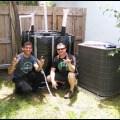


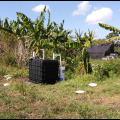
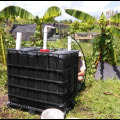

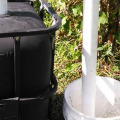
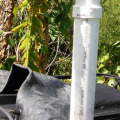
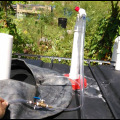
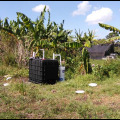
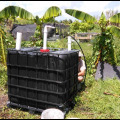
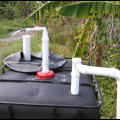
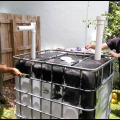
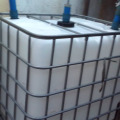
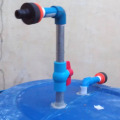
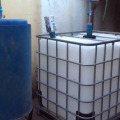
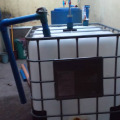
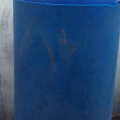
Useful.
Useful.
Superb idea. I really like ur
Superb idea. I really like ur project. Tx a lot and give up with ur good work.
Tx
The hieght of the outlet pipe
We have made a biodigestor here in Grafton, NSW, Australia.
We are still waiting for it to produce the gas as it is still new. We are concerned about the height of the outlet pipe. Will it still drain even thought it is taller than the height of the tank? Will the water level needed to start the draining block the gas out let hole inside the tank? We used the 8 miniute video to make the biodigestor and are just concerned it shows a tall outlet pipe, like we've got. My husband thinks this design will not allow gas to escape as the water level will need to be over the gas outlet, to drain. Anyone got any thoughts?
Cheers Taya
Gas will always float to the
Gas will always float to the surface of a liquid, so even if your tank is full to the top; as gas is formed, it will bubble up to the highest point and escape from the outlet hole. As for drainage, the outlet channel should be lower than the input channel, if thats the case, then as you feed the digestor, any extra liquid will flow out from the shortest pipe first. I would only recommend keeping your gas outlet closed during feeding to prevent any sludgy material going up the gas outlet tube and creating clogging.
Biodigester output
Trying to design a system(NY) that is seamless, with kitchen sink connected to my biodigester. Is it possible to connect a small intermediate biodigester bladder to my house gas line with a shutoff valve, a check valve.
House gas pipe + shut off valve + check valve + 1/2" hose barb connected to rubber bladder.
House gas is prevented from entering bladder via a check valve. Pressure on check valve is controlled via the shutoff valve. When cooking, gas flows into house gas line supplementing need. No need to store a large amount of gas.
Putting it in a greenhouse.
I am planning on building a biogas generation and putting it in my greenhouse to keep it warm. And maybe use it to heat the greenhouse in winter.
Why have a separate gas
Why have a separate gas storage tank? Why not, instead of having the gas tank storage full of water, you fill it with slurry and it produces gas direct rather than having to pipe gas from one tank to another?